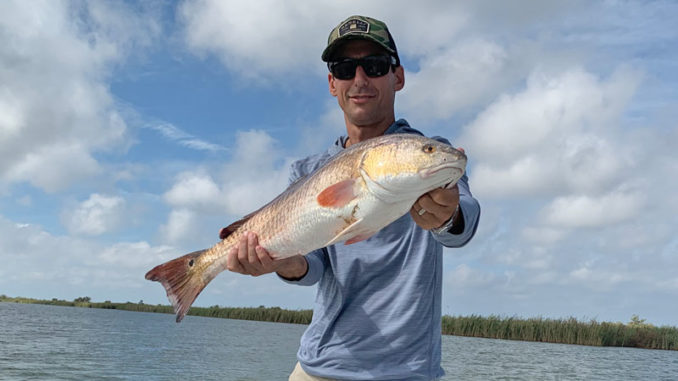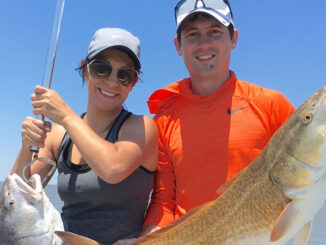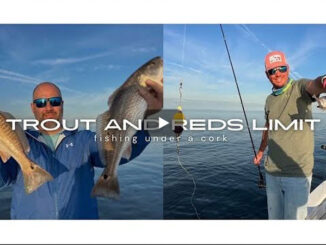
LWFC reviews information from angler opinions on restrictions
Sixty percent of Louisiana residents with saltwater fishing, lifetime or senior licenses who responded to a recent survey said they support current red drum (redfish) regulations. The survey was conducted by e-mail and web-based surveys.
The survey went to 13,000 randomly selected Louisiana licensed residents, however, there was no way to determine how many of those actually fish for redfish. Only thirteen percent, or 3,900 people responded, according to Dr. Jack Isaacs, an economist who compiled the data for and presented it to the Louisiana Wildlife and Fisheries Commission (LWFC) at their regular May 4 monthly meeting.
Dr. Isaacs said 158 pages were received from resident comments. Thirty-five pages were received about bow fishing. He went over survey numbers with Louisiana Wildlife and Fisheries Commission (LWFC) members at their regular May 4 monthly meeting. Commission members will review information and possibly introduce a Notice Of Intent (NOI) in their June or July meeting to accomplish a 35 percent reduction of the redfish harvest.
“If the commission decides to move forward with changes in the regulations there is going to be a lot of people pressing about this issue,” Isaacs said. “Red drum is a really, really complicated issue.”
At their December 2022 meeting, LWFC members reviewed red drum stock numbers that showed numbers being depleted at a rate that possibly would require management changes.
Basic questions
The survey asked basic questions concerning red drum and also gave options of the type of regulations fishermen would prefer. The survey focused on management tools, minimum size, slot limit, width of slot limit, a strict slot or modified slot and bag limits.
“What are the combination of those elements that folks seem to favor relatively more than others?” Isaacs pondered. “The whole idea was not necessarily to come up with a single correct answer, but to narrow the possible answers down.”
Initially, the survey offered 24 combinations to narrow the parameters people were willing to consider or parameters that would meet less resistance. Options picked were 16-24 inch option with just 19 percent approval rate; 17-20 inch had some support; and low bag limits, according to Isaacs.
The responses did not reflect many clear-cut opinions on what direction should be taken. According to the web survey, 49 percent preferred smaller minimum, smaller bag combination.
Eighty-four percent of people who responded by email fished for redfish in fresh water and 98 percent in the web-based survey. People averaged 11 trips fishing per year in the email responses, while the web-based survey showed 29 trips per year on average. It was not a “huge difference” between the zones of red drums caught, according to Isaacs.
Current regulations
Current regulations on red drum is a 16 – 27 inch size limit and five per person per day. Overall, LDWF’s red drum target is a 35 percent reduction in harvesting. Some in the public that spoke out during the meeting wanted the reduction percentage to be higher.
LDWF monitors two portions of the red drum stock, the juvenile stock (up to age 5 and generally under 27 inches in length) that resides in inshore waters and the adult spawning population (greater than age 5) in nearshore coastal waters. Red drum is unique in that the vast majority (97%) of harvest is on the juvenile stock when it is between 16 and 27 inches in length or about 1.5 to 4 years old. Given this type of harvest strategy, the amount of red drum that moves through the fishery and into the offshore spawning population is critical to the future status of the stock, LDWF said.
In a separate Louisiana Charter Boat Association survey, data was more emphatic, showing 82 percent were in favor of banning or greatly reducing bull red harvesting. Fifty-nine percent were in favor of going to a four bag limit and reducing the size limit.
Legislative bills
The LWFC also once again reviewed bills being discussed in the 2023 Legislative Session.
Cole Garrett, general counsel, reviewed the bills with members.
House Bill (HB) 4 was referred to the House Administration of Criminal Justice and dealt with criminal trespass on running waters. The bill stated that criminal trespass shall not apply to any person operating a vessel on running waters of the state.
“We have a lot of coastal WMAs that have natural waters running through them,” Garrett said. “There has been a concern that this is going to overturn juris prudence of private canals on private property but this may also have an impact on the property that we own and manage as well. I think that is to be determined.”
HB 297 deals with the prescription of litter violations. If passed, it would create a two-year prescription period, expanding the current six-month period, to prosecute simple or intentional litter violations. HB 299 deals with the enforcement of federal firearms laws.
“This would be a prohibition of enforcing certain federal firearm laws,” Garrett said. “As we are federally commissioned agents and this puts us in an awkward position to uphold certain federal laws but not others. It has not been scheduled for a hearing yet, and I don’t know if it will be.”
Wildlife-related bills
Concerning the wildlife-related bills, HB 570 was voluntarily deferred in committee. This bill would have established a $5 bounty on feral hog tails. Louisiana has a growing problem with feral hog overpopulation and increasing damage they cause in all 64 parishes.
Senate Bill (SB) 119, a bill LDWC opposes, would repeal the youth hunting license requirement. LDWF collected $100,000 from licenses and $750,000 in federal money from selling the privilege, according to Garrett. There was no discussion of how that money is spent. However, Garrett said youth license for deer and turkey was $5, an amount that did not put a “burden” on any hunter.


